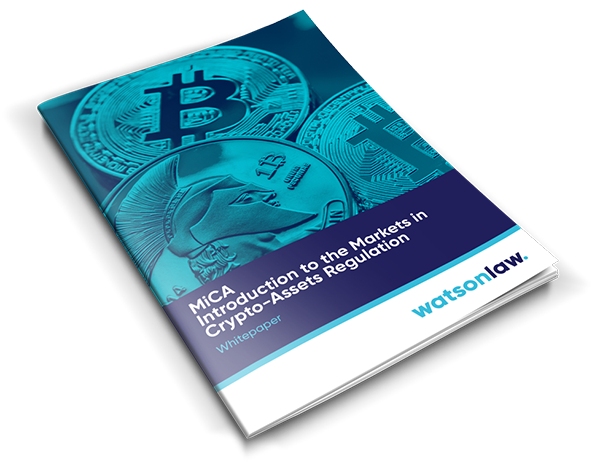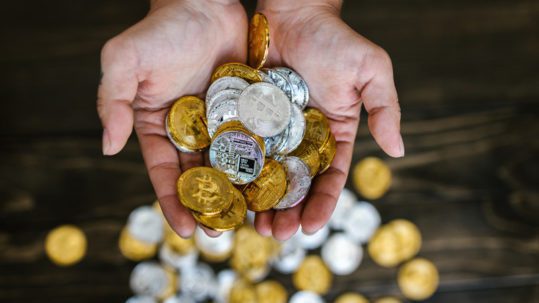If your company provides services in the crypto sector, you may qualify as a CASP. One of the tokens you provide these services to must qualify as a crypto-asset, and the service you provide must qualify as one of the following:
- Providing custody and administration of crypto-assets on behalf of clients;
- Operation of a trading platform for crypto-assets;
- Exchange of crypto-assets for funds;
- Exchange of crypto-assets for other crypto-assets
- Execution of orders for crypto-assets on behalf of clients;
- Placing of crypto-assets;
- Reception and transmission of orders for crypto-assets on behalf of clients;
- Providing advice on crypto-assets;
- Providing portfolio management on crypto-assets;
- Providing transfer services for crypto-assets on behalf of clients.
If you qualify as a CASP, you must obtain a license from the regulator. This license is then valid for the entire EU. For this, your company must be a legal entity established in the EU. If your company wishes to offer these services in several Member States, the following information must be submitted to the local regulator:
- A list of the Member States in which the CASP intends to provide the services;
- A list of all crypto-asset services it intends to offer on a cross-border basis;
- The starting date of the intended provision of the services; and
- A list of all other activities carried out by the CASP that are not covered by MiCA.
MiCA includes a number of rules that apply to all CASPs, such as organisational requirements and prudential requirements. In addition, specific requirements are included per service that can be offered by a CASP. MiCA also distinguishes between three classes of CASPs. Based on this, minimum capital requirements are set for a CASP.
4.1 Custody and administration of crypto-assets on behalf of third parties
When your company provides custody and administration services on behalf of third parties, there are a number of rules that must be met:
- The CASP enters into an agreement with the client that specifies their duties and responsibilities;
- The CASP keeps a register of each position opened on behalf of a client;
- The CASP shall establish a custody policy, which shall ensure that crypto-assets will not be lost through fraud, cyber-threats or negligence;
- The CASP shall facilitate the exercise of the rights attached to the crypto-assets;
- The CASP shall provide its clients with a position statement at least every three months;
- The CASP shall ensure that necessary procedures are in place to return crypto-assets as soon as possible to its clients;
- The CASP shall maintain segregated assets.
The custody and administration of crypto-assets is a Class 2 service. This means that the CASP must have a minimum capital of €125.000.
4.2 Operating a trading platform for crypto-assets
When your company operates a trading platform for crypto-assets, there are a number of rules that must be met:
- The CASP establishes operating rules;
- The CASP does not trade on its own trading platform for its own account;
- The CASP has effective systems, procedures and arrangements to ensure resilience, sufficient capacity and order rejection;
- The CASP makes any bid and ask prices and the depth of trading interests public through its own systems;
- The CASP completes settlement of transactions on the same day as they are executed;
- The CASP maintains transparent fee structures;
The operation of a trading platform is a Class 3 service. This means that the CASP must have a minimum capital of €150.000.
4.3 Exchanging crypto-assets for funds or other crypto-assets;
When your company exchanges crypto-assets for funds or other crypto-assets, there are a number of rules that must be met:
- The CASP establishes a non-discriminatory policy regarding client acceptance and conditions;
- The CASP publishes a firm price or a method of determining the price;
- The CASP executes orders at the prices displayed at the time of reception;
- The CASP makes public the details of orders and transactions.
The exchange of crypto-assets for funds or other crypto-assets is a Class 2 service. This means that the CASP must have a minimum capital of € 125.000.
4.4 Execution of orders for crypto-assets on behalf of third parties
When your firm executes orders for crypto-assets on behalf of third parties, there are a number of rules that must be met:
- The CASP shall take all necessary steps to obtain the best possible result for its clients, unless the CASP executes orders in accordance with specific instructions from its client;
- The CASP establishes and implements effective execution arrangements;
- The CASP provides appropriate and clear information to its clients about its order execution policy and any significant changes thereto;
- The CASP shall demonstrate to its clients, at their request, that they have executed their orders in accordance with their execution policy;
- The CASP shall monitor the effectiveness of their order execution arrangements and policy.
The execution of orders for crypto-assets is a Class 1 service. This means that the CASP must have a minimum capital of €50.000.
4.5 Placing of crypto-assets
When your company places crypto-assets, there are a number of rules that must be followed:
- The CASP shall communicate information to the issuer, before they enter into a contract, regarding:
- The type of placement considered;
- The amount of transaction fees involved in the proposed operation;
- The timing, process and price; and
- Information about the targeted purchasers.
- The CASP shall obtain the issuer’s consent in relation to the above points prior to the placement;
- The CASP shall include in the conflict of interest rules specific information relating to the following situations:
- The CASP places the crypto-assets with its own clients;
- The proposed price for the placement is over- or underestimated;
- Incentives, including non-monetary, are paid or granted by the offeror to the CASP.
Placement of crypto-assets is a Class 1 service. This means that the CASP must have a minimum capital of € 50.000.
4.6 Receiving and transmitting orders for crypto-assets on behalf of third parties
When your company transmits orders involving crypto-assets, there are a number of rules which must be complied with:
- The CASP shall establish and implement procedures that provide for the prompt and proper transmission of client orders;
- The CASP does not receive any renumeration, discount or non-monetary benefit for transmitting to a particular trading platform or CASP;
- The CASP does not misuse information about pending orders and takes all reasonable steps to prevent misuses of such information.
The receipt and transmission of orders for crypto-assets is a Class 1 service. This means that the CASP must have a minimum capital of € 50.000.
4.7 Advice on crypto-assets and portfolio management of crypto-assets
When your company provides advice on crypto-assets or portfolio management of crypto-assets, there are a number of rules that must be met:
- The CASP only recommends crypto-assets if it is suitable for its client, based on their knowledge, experience, objectives and financial situation;
- The CASP shall inform potential clients of whether the advice is provided on an independent basis and whether the advice is based on a broad or on a more restricted analysis of different crypto-assets;
- The CASP shall provide the potential clients with information on all costs and associated charges;
- The CASP shall assess a sufficient range of crypto-assets and the CASP shall not accept and retain fees, commissions or any monetary or non-monetary benefits paid by any third party;
- The CASP shall, in the case that the advice is provided on a non-independent basis, inform the client that the CASP can receive inducements under the conditions that the payment is designed to enhance the quality of the service and does not impair compliance with its duty to act honestly, fairly and professionally;
- The CASP shall ensure that natural persons providing advice or information on its behalf have the necessary knowledge and experience;
- The CASP shall seek information on the client’s knowledge and experience with crypto-assets, on the client’s objectives, on the client’s financial situation and on a basic understanding of the risks associated with crypto-assets;
- The CASP shall warn the client that the value of crypto-assets may fluctuate;
- The CASP informs clients that crypto-assets may be unsuitable for them and warns them of the risks if the CASP believes that the client has insufficient knowledge;
- The CASP shall review its assessments for each client every two years;
- The CASp provides client with a summary of the advice provided to that client and with periodic statements of the activities carried out on behalf of that client.
Advice on crypto-assets and portfolio management of crypto-assets is a Class 1 service. This means that the CASP must have a minimum capital of € 50.000.
4.8 Providing transfer services for crypto-assets on behalf of third parties
When your company provides transfer services for crypto-assets on behalf of third parties, there are a number of rules that must be met:
1. The CASP shall enter into an agreement with their clients to specify their duties and responsibilities. Such agreement shall include at least the following:
- The identities;
- The modalities of the transfer provided and a description of that service;
- A description of the security systems used by the CASP;
- The charges applied by the CASP;
- The law applicable to the agreement.
Providing transfer services for crypto-assets on behalf of third parties is a Class 1 service. This means that the CASP must have a minimum capital of € 50.000.












